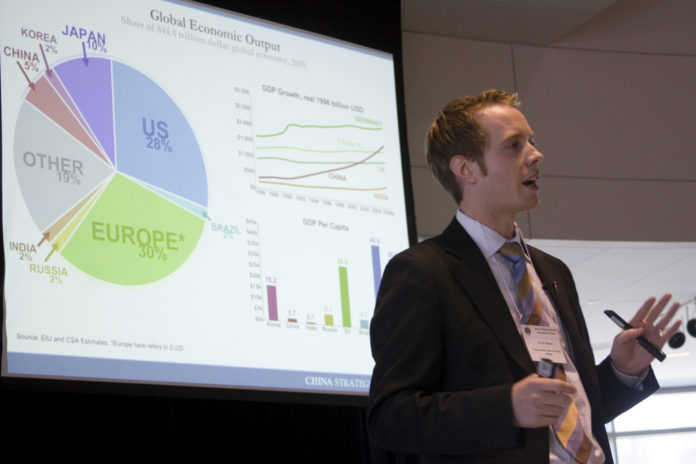
In the year 2040, Bryant University and Brown University students now studying economics and trade will be in their early to mid-50s. And they will live in a world where the United States’ economy is second to China’s, according to Goldman Sachs’ forecasts.
“Students must know about the global economy in which they will work,” said Nancy Biersteker, an economist and professor at Bryant who organized a two-day conference on April 13 and 14 called “Rise of the New Asian Giants.”
The event explored public and private-sector responses to trade expansion in China and India. “With this knowledge,” Biersteker said, students “will be better equipped to deal effectively with the new competitive landscape.”
Biersteker required her 150 macroeconomics students to attend the first day of the conference, held at Bryant, while Brown students had the opportunity to attend the second day on their campus, co-sponsored by the Watson Institute for International Relations.
The first day started with an overview of some of the strengths and weaknesses of China’s and India’s economies.
Trevor Houser, analyst for China Strategic Advisory LLC, said that despite China’s major comparative advantages, such as cheap labor, the country still is missing the mark when it comes to research and development and innovation strategies, which add the most value to products.
The lack of intellectual property protection takes away the incentive to innovate, he added, and that will hurt China in the long run. A lack of proximity to the U.S. market and lack of Chinese brand recognition also could hurt China’s competitiveness.
But that doesn’t mean China is not a force to be reckoned with.
“Europe has to accept fierce competition with China,” said Iren Borissova, special adviser for the trade section of the Delegation of the European Commission to the United States. “[And] China has to ensure it is a fair competition.”
And that’s not easy, considering the country is still operating as a non-market economy that favors export maximization at all costs, including economic subsidies and corruption.
Perhaps the most heated speakers were the CEOs of two textile companies that have been directly impacted by the emergence of China as a major player in the world market, although they were tossing more criticism at the United States than China for the competitive disadvantages of U.S. manufacturers.
George Shuster, chairman and CEO of Cranston Print Works, called for major reforms of U.S. trade policies that would level the playing field for smaller manufacturers. He said current policies favor large multinational corporations whose export production platforms are in low-cost countries.
He pointed to statistics on tariffs to prove his point, saying that the average U.S. tariff on imports is 1.3 percent, while U.S. exports face an average tariff of about 40 percent when entering other countries.
“We are told our policy is free trade, but the real policy is import maximization to encourage … making products abroad and bringing them back,” he said. “Our own government is directing the hollowing out of U.S. manufacturing. … We all better start screaming that this is a folly of monumental proportions.”
Larry Liebenow, president and CEO of Quaker Fabric Corp. in Fall River, an upholstery manufacturer that has struggled to survive in recent years, also directed criticism to the United States, but his had more to do with the overregulation of publicly traded companies.
He said Quaker Fabric spends $2 million a year to comply with the Sarbanes-Oxley Act.
“Quaker gets zero benefit from that,” he said. “Quaker’s shareholders and other stakeholders get zero value from that money. What it does mean is we have less money to invest, and it means that our prices have to be higher while we are trying to compete in this extraordinarily competitive market.”











